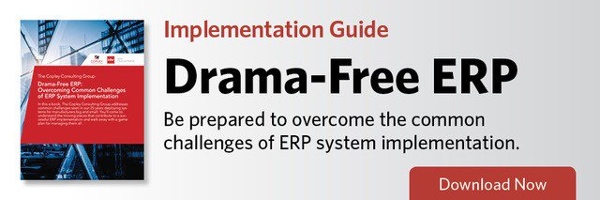In this special blog series, we’ll be discussing common challenges we’ve seen in our 25 years deploying ERP systems for manufacturers. Over the next few weeks, you’ll come to understand the moving pieces that contribute to a successful implementation and walk away with a game plan for managing them all.
Although it’s not a reality any business wants to face as they enter an ERP deployment, the truth is that not all ERP implementations are successful. In fact, according to Gartner Research, as many as 55% to 75% of ERP implementations fail to meet their objectives.
While post-launch issues can range from technical to logistical, we’ve seen that one of the biggest – and most overlooked – components of ERP success is effectively managing change within your organization. In this blog, we talk through four phases of change management that are critical to a drama-free ERP implementation.
Make the Case for Change
A common misstep made by companies eager to adopt ERP is to dive in before their organization is truly ready. The last thing you want to do is blindside your workforce with a new system that disrupts their standard operating procedures. Change management needs to begin before a change even occurs – and it needs to start at the top.
Talk with your company’s C suite to understand whether you have leadership buy-in, and if you sense hesitation, be prepared to make your case. Map out your post-ERP vision to help key stakeholders understand the benefits of a new system. Take the time to explain the consequences of failing to make the change. And be clear about what you will need in terms of budget and resources to be successful.
By presenting your case at an early stage, you make leadership a part of the decision-making process and demonstrate their stake in your success. Not only that, you’ll mobilize a team of high-level advocates to express their support even before project kickoff.
Face the Resistance
In order to overcome resistance to change, you must first understand it. Even if your company has never implemented an ERP system before, institutional history may reveal some lessons about how big changes are received in your corporate climate.
If your workforce has been averse to change in the past, or if your company has undergone a lot of big changes recently, then a tactful introduction to the initiative will be especially critical. Conduct an organizational readiness assessment to gauge employee interest and concern. Think through how your ERP system can fit into your current culture, not the other way around. Consider employees’ top objections, and tackle them head on in a company-wide presentation or project dashboard.
By creating a change management and communication plan that covers these bases, you’ll be in a much better position to minimize project resistance throughout ERP development and beyond.
Be Proactive
Before unleashing the wonder of ERP on your workforce, take the time to fully understand how the system will impact the daily working life of your employees.
Stay a step ahead of your deployment by thinking through whether processes will need to change and how individual roles will be affected. If you don’t know the answers to these questions, then talk to the people who do. Bring together a network of department heads to discuss how they see ERP aligning or conflicting with their current procedures.
By opening this communication channel early, you give key influencers a vested interest in the project’s success. You also give them the opportunity to bring anticipated issues to the table quietly before they can blow up – and the power to act quickly with an appropriate, team-backed solution.
Be Reactive
Of course, a critical component of ERP success is a comprehensive and thoughtfully designed training program. But a winning user adoption strategy goes beyond one-way knowledge sharing. It’s a two-way conversation that continues long after your go-live date.
This means proactively providing self-guided materials, such as an ERP vocabulary list and implementation handbook, for users to refer to – but also recognizing that these resources won’t answer all their questions. Be prepared to troubleshoot employee issues by setting up a clear point of contact for each department, be it an internal super user or an external support resource. Keep standing meetings with your ERP team so you can collectively respond to post-launch challenges with consistent and timely direction.
And finally, don’t just mobilize and communicate when there is a fire to be put out. Call out ERP-related achievements. Measure key performance indicators to demonstrate organizational progress. Recognize the skills and dedication of your super users – and the strides made by your not-so-super users. Only by driving home the benefits of the system and the successes it has inspired will ERP become a celebrated and fully integrated component of your company culture.
If you’re ready to move ahead with your ERP selection, check out the Infor CloudSuite Industrial solution. We know that advancing and maintaining information management solutions can be a constant challenge. If you are looking for an ERP implementation partner, The Copley Consulting Group may be the right partner for your mid-size business.

